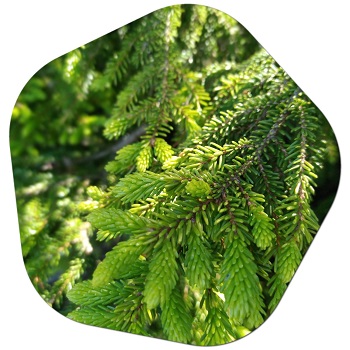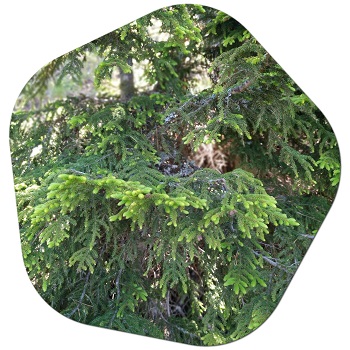Spruce trees are found in various regions across Canada. They are a common tree species in the country and have a wide distribution. Here are some of the areas where spruce trees can be found:
- Boreal Forest: Spruce trees, particularly black spruce (Picea mariana) and white spruce (Picea glauca), are prevalent in Canada’s vast boreal forest, which spans across several provinces and territories. This forest biome covers much of northern Canada, including parts of Yukon, Northwest Territories, Nunavut, British Columbia, Alberta, Saskatchewan, Manitoba, Ontario, and Quebec.
- Coastal British Columbia: British Columbia, particularly the coastal regions, is known for its abundance of spruce trees. Sitka spruce (Picea sitchensis) is a common species found along the Pacific coast of British Columbia, including Vancouver Island and the Great Bear Rainforest.
- Canadian Rockies: In the mountainous regions of Alberta and British Columbia, spruce trees can be found at higher elevations. Englemann spruce (Picea engelmannii) and subalpine fir (Abies lasiocarpa) are examples of tree species that thrive in the Canadian Rockies.
- Newfoundland and Labrador: Black spruce is the provincial tree of Newfoundland and Labrador. It is found throughout the province, particularly in the boreal forests and peatlands.
- Northern regions: Spruce trees are well-adapted to colder climates, and they are found in northern regions across Canada, including the territories of Yukon, Northwest Territories, and Nunavut.

Please note that these are general regions where spruce trees are commonly found in Canada. The specific distribution and abundance of spruce trees may vary within these regions due to local conditions, such as soil type, climate, and elevation.
Information about spruce trees growing in Canada
Spruce trees are an important component of Canada’s forests and play a significant role in the country’s ecosystems. Here is some information about spruce trees growing in Canada:
- Species: Several species of spruce trees are found in Canada, including black spruce (Picea mariana), white spruce (Picea glauca), red spruce (Picea rubens), Engelmann spruce (Picea engelmannii), Sitka spruce (Picea sitchensis), and others. Black spruce and white spruce are among the most common and widely distributed species.
- Distribution: Spruce trees are found across Canada, from the eastern provinces to the western regions and northern territories. They are particularly abundant in the vast boreal forest that stretches across the northern parts of the country. Spruce trees can also be found in British Columbia’s coastal regions, the Canadian Rockies, Newfoundland and Labrador, and the northern territories of Yukon, Northwest Territories, and Nunavut.
- Characteristics: Spruce trees are coniferous evergreen trees that can reach varying heights depending on the species and growing conditions. They typically have needle-like leaves that are sharp and stiff, arranged individually on the branches. The cones of spruce trees are cylindrical and hang downward. Spruce wood is commonly used for construction, furniture, and pulp production due to its strength and durability.
- Adaptations: Spruce trees are well-adapted to the Canadian climate, particularly in colder regions. They can withstand harsh winter conditions, including freezing temperatures and heavy snowfall. Spruce trees have developed adaptations such as flexible branches to prevent breakage under the weight of snow and needle-like leaves that minimize water loss during winter.
- Ecological Importance: Spruce trees provide numerous ecological benefits. They contribute to carbon sequestration, helping mitigate climate change. Spruce forests provide habitat for various wildlife species, including birds, mammals, and insects. They also help stabilize soils, regulate water flow, and protect watersheds.
- Economic Significance: Spruce trees have economic importance in Canada. The timber industry relies on spruce wood for a variety of products, including lumber, pulp, and paper. Forest management practices in Canada aim to ensure sustainable harvesting of spruce and other tree species.
It’s important to note that the specific characteristics and distribution of spruce trees may vary depending on the species and the region within Canada.
Are there spruce trees in Canada?
Yes, spruce trees are found in Canada. Canada is home to various species of spruce trees, including black spruce (Picea mariana), white spruce (Picea glauca), Sitka spruce (Picea sitchensis), Englemann spruce (Picea engelmannii), and others. Spruce trees are widely distributed across Canada’s diverse forested regions, including the boreal forest, coastal areas, mountainous regions, and northern territories. They play a significant role in the country’s ecosystems and are an important part of Canada’s natural heritage.
When to prune spruce trees in Canada?
Pruning spruce trees in Canada is typically recommended during specific times of the year to ensure their health and promote optimal growth. Here are some guidelines for pruning spruce trees in Canada:

- Timing: The best time to prune spruce trees is during late winter or early spring before new growth begins. Pruning during this dormant period allows the tree to recover quickly and minimizes the risk of disease or pest infestation. It is generally recommended to avoid pruning during the late summer or fall when the tree is preparing for winter dormancy.
- Specific Months: In most regions of Canada, late February to early April is considered an ideal time for pruning spruce trees. This timing may vary slightly depending on local climate conditions, so it’s a good idea to observe the tree and prune when the buds are still dormant but before they start to swell.
- Dead or Diseased Branches: Pruning dead, damaged, or diseased branches can be done at any time of the year as soon as the issue is identified. Prompt removal of these branches helps maintain the overall health and appearance of the tree.
- Pruning Goals: When pruning spruce trees, it is important to have clear objectives. Common goals include removing dead or damaged branches, improving the tree’s shape and structure, and reducing any potential safety hazards. Pruning should be done selectively, avoiding excessive removal of branches that could negatively impact the tree’s health.
- Pruning Techniques: When pruning spruce trees, it is recommended to use proper pruning techniques. This includes making clean cuts just outside the branch collar (the swollen area where the branch meets the trunk), using sharp and clean pruning tools, and avoiding excessive pruning that can stress the tree.
Keep in mind that these are general guidelines for pruning spruce trees in Canada. It is always a good idea to consult with a local arborist or tree care professional who has knowledge of the specific species and regional considerations in your area before undertaking any major pruning activities. Where to find spruce trees in Canada? >>
What types of spruce trees are found in Canada?
Several types of spruce trees are found in Canada. Here are some of the common spruce species that are native or naturalized in Canada:
- Black Spruce (Picea mariana): Black spruce is a dominant tree species in Canada’s boreal forest. It is well adapted to cold climates and has a wide distribution across the country, particularly in northern regions.
- White Spruce (Picea glauca): White spruce is another common spruce species in Canada. It is found throughout the boreal forest and extends into the northern parts of the United States.
- Red Spruce (Picea rubens): Red spruce is primarily found in eastern Canada, particularly in the Appalachian Mountains of Quebec and the Maritime Provinces.
- Sitka Spruce (Picea sitchensis): Sitka spruce is native to the Pacific Northwest of North America, including coastal British Columbia. It can also be found in southeastern Alaska.
- Engelmann Spruce (Picea engelmannii): Engelmann spruce is primarily found in the Rocky Mountains, including parts of Alberta and British Columbia.
- Whitebark Pine (Pinus albicaulis): While not a spruce tree, whitebark pine is an important high-elevation tree species in western Canada, particularly in the Rocky Mountains. It is included here due to its ecological significance. How much spruce grows in Canada?
These are some of the main spruce tree species found in Canada. Each species has its own specific characteristics, preferred habitats, and ranges within the country.
